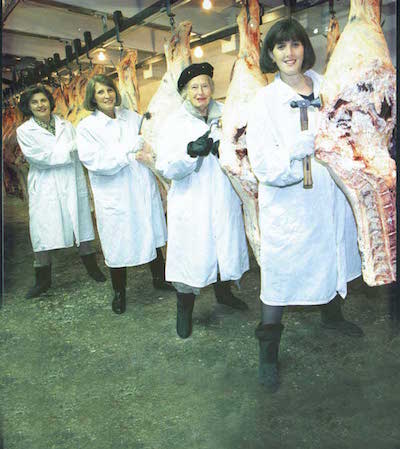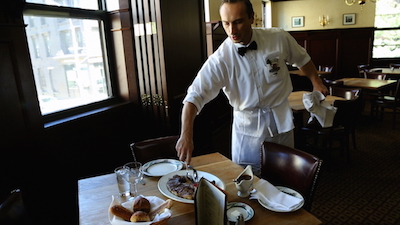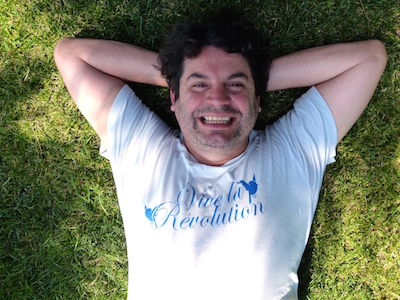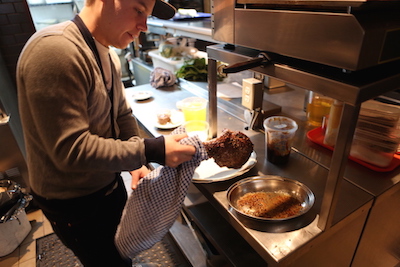“STEAK (R)EVOLUTION” Film Leaves Out America’s Finest
 (Gerry Furth-Sides) Acclaimed French director-producer Franck Ribiere, who turns out to also be a dedicated carnivore, takes us on an international search for the best and healthiest steak in the world in the documentary STEAK (R)EVOLUTION. It plays exclusively for a one-week engagement at Landmark’s Nuart Theatre, starting August 28.
(Gerry Furth-Sides) Acclaimed French director-producer Franck Ribiere, who turns out to also be a dedicated carnivore, takes us on an international search for the best and healthiest steak in the world in the documentary STEAK (R)EVOLUTION. It plays exclusively for a one-week engagement at Landmark’s Nuart Theatre, starting August 28.
The passionate Ribiere entices us with images of butter-dripping luxury steaks and provokes us with a comprehensive tour to think about how beef is most humanely – and thus best-brought to table, and so all the more enjoyed. Winner of the Best Documentary COLCOA 2015, watch the trailer here //www.youtube.com/watch?v=45g90TCJ5OU.
So how could they have left out Piedmontese Beef, both in Italy and the USA, giving a nod fleetingly to cousins, the Chianina in the Piedmont area?
Ribiere’s visit to historic Peter Luger Restaurant in Brooklyn, USA is the inspiration for the film although he leaves out America’s finest altogether (Piedmontese). Yet even Robiere’s interspersed shots of his Peter Luger experience alone, from the painstaking preparing of the meat and ritual steak meal at table to interviewing the current family owner (trained with her aunties to purchase meat, as shown below) are enough to make you phone in a reservation to the legendary steakhouse and buy a ticket to NY.


Ribiere’s family set the bar high, raising their own Charolais cows in France, which at one time he thought were the absolute best, and with good reason. That was until he experienced a steak at the famed Peter Luger’s in Brooklyn, New York, considered the oldest steakhouse in America. Could anything be better?

The director has his doubts. And so he embarks with us on a journey around the world – well, Japan, UK, USA anyway, with his trusty expert guide and favorite butcher,Yves-Marie Le Bourdonnec. The steaks are numbered in a countdown but that is the most cohesive element of the documentary that is so richly filmed but seems to lack editing – and comes in at over two hours! Still, such “moments,” such as the Japanese couple who bow and express their honor over being included in the film before they introduce the filmmaker to their pampered cattle, are worth the price of admission. And the notion that great beef prepared even in a stove pan the proper way sets a standard for excellence.

Director Ribere describes his quest: “I took the point of view of a consumer who loves meat. My approach was therefore first and foremost to look for quality products and also to try to understand the producer’s philosophy.” At over two hours, the film feels unedited and very much the seemingly casual trips taken in every direction, also interspersing footage from Peter Lugar’s here and there.
The story is told through interviews with passionate cattle breeders, professional butchers, chefs, meat experts and steak house operators, to come to a conclusion about how good and healthy red meat can be achieved—and why it is becoming a luxury product. Most of them are detailed and informative. They indirectly advocate moving toward sustainable farming practices and smaller-scale operations as one positive change, just about literally a film pairing Michael Pollan’s The Omnivore’s Dilemma (2006).

Far from large cattle farms with their industrial output, Ribière and Le Bourdonnec’s coverage extends from the surprisingly great beef in Great Britain (including grass-fed crazy Australia and New Zealand, to the raising of Kobe in Japanese spa-like conditions. One of the most fascinating segments, and yet treated as a novelty rather than one of the main elements in raising beef, is a breeder whose cattle live to the very, very ripe old age of 14 or so (rather than two). The cost of raising and feeding cattle could have been the focal point of the entire film.
We were heartbroken that they left out Piedmontese Beef, both in Italy and the USA, giving a nod fleetingly to cousins, the Chianina in the Piedmont area. The reason for the regality of Piedmontese is because the cattle have 1 or 2 copies of the inactive myostatin gene, which provides a higher lean-to-fat ratio. It is less marbled and has less connective tissue, thus more tender yet less fatty. This low fat beef is also lower in calories, higher in protein and contains a higher percentage of the good Omega 3 Fatty Acid. Piedmontese cattle spend the majority of their lives on grass and are finished on grains.
We did our own local research after the manager of Del Frisco Grille, billing itself as a “sophisticate chophouse chain serving steak…..) insisted on hosting us to try “the best steak in the world” at the Santa Monica location. Although he didn’t come out to watch our reaction, the chefs and staff eagerly awaited our reaction with baited breath as they brought out the ribeye, grilled at a high heat with no other seasoning than a coat of salt and pepper. The beef had a definite bite and distinct taste.
And so we give the last word to Del Frisco Grille’s National Director of Purchasing, Dave Tashman, who explains that the Del Frisco Grille’s beef is 100% Eastern Corn Fed, USDA Prime, and, like most American cattle, are raised on range or pasture for most of their lives and end life in the traditional and most humane way possible. In his words, “this method provides the marbling, flavor and makes US meat better than any beef in Europe or Great Britain. Millennials think grass-fed cattle is better but in reality most grass fed are ‘finished’ on some form of of non-grass veggies, usually corn, for the luscious mouthfeel and the best taste in the world.” (delfriscosgrille.com/santa-monica).

Another French director, the legendary, Academy Award winning director, René Clément and his iconic post-war masterpiece, Forbidden Games (1951) arrives with Steak (R)Evolution at the NuArt this week with a new digital presentation and translation. Plenty of table scenes, with lots of entrees, albeit straight from the field, made into finger food at the rustic dining table, round out the compelling friendship of two youngsters, five-year-old Brigitte Fossey and 11-year-old Georges Poujouly, a country boy who somehow acts in a regal manner amidst the idiotic peasant feuds of the adults around him.

After Brigitte’s parents are killed by an air strike while the family flees Paris during the German invasion, she wanders off in her gorgeous little fashionable dress, into the nearby bucolic surroundings and a life as alien from the city as if were on another planet. The two youngsters form a special, secret bond that makes a lot more sense than the behavior of the adults around them, whose petty feuds mirrors that of the world war going on in what feels like a distant rest of Europe. Narciso Yepes’ haunting guitar vituoso score ranks right up there with that of The Third Man’s inspired zitherist, Anton Karas. The personal and disturbing, Forbidden Games, shot in stunning, elegant black and white, proves to be timeless after winning the Golden Lion at the Venice Film Festival, the Independent Grand Prix at Cannes, the Best Foreign Film Award from the New York Film Critics Circle, and Clement’s second Academy Award® for Best Foreign Film.
Trailer: //www.youtube.com/watch?v=6_m00tBc1I4



 Gerry Furth-Sides
Gerry Furth-Sides  Barbara Hansen
Barbara Hansen  Chef-owner Alain Cohen
Chef-owner Alain Cohen  Roberta Deen
Roberta Deen  Jose Martinez
Jose Martinez  Nivedita Basu
Nivedita Basu